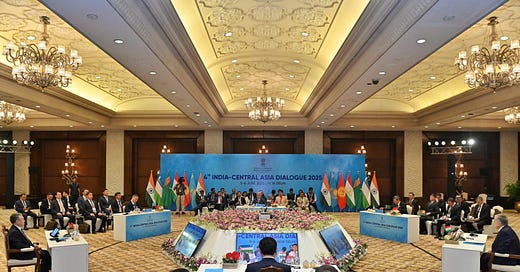Highlands and High Seas
In this week’s edition of The Indian Radius, we discuss the visit of the five Central Asian Foreign Ministers, India-EU Strategic Dialogue, the US-Japan-Australia trilateral and the UN Ocean Conference.
Synergies on the Steppe
At the 4th India–Central Asia Dialogue last week, Foreign Ministers from Kazakhstan, Kyrgyzstan, Tajikistan, Turkmenistan, and Uzbekistan met Prime Minister Modi and Dr Jaishankar in Delhi. With a strong emphasis on counterterrorism, there was a collective resolution to hold perpetrators, financiers, and sponsors accountable.
The countries also voiced interest in joint exploration of rare earth and critical minerals. The move follows rising global unease over China’s curbs on rare earth exports, which have unsettled sectors ranging from automobiles and clean energy to defence. The partners also called for an early convening of the India–Central Asia Rare Earth Forum, held in September last year.
The meeting saw a renewed focus on the International North–South Transport Corridor (INSTC), including utilisation of Chabahar Port’s Shahid Beheshti Terminal. Agreements were signed to strengthen financial connectivity via digital payments, interbank ties, local currency trade, along with the establishment of a Digital Partnership Forum.
Beyond reiterating shared concerns over terrorism and energy security, the dialogue’s focus on critical minerals, business-to-business ties, and trans-regional connectivity reveals a maturing relationship. With the Shanghai Cooperation Organisation scheduled for autumn 2025 in China, providing another occasion for engagement, it remains to be seen whether Central Asia emerges as a zone of shared opportunity or of strategic contestation.
Over the Seine
External Affairs Minister Dr S. Jaishankar is on a visit to France, Belgium and the European Union. He held bilateral meetings with French FM Jean‑Noël Barrot in Paris & Marseille, marking 25 years of strategic partnership with France.
The week also saw the first-ever India–EU Strategic Dialogue with High Representative and Vice President of the European Commission, Ms. Kaja Kallas in Brussels. The dialogue is an important step in building political and strategic trust between India and the EU. It paves the way for elevating relations beyond trade into defence, cybersecurity, and space policy domains.
The minister also engaged with Belgian leaders, including FM Maxime Prévot, highlighting strong economic links in green energy, pharmaceuticals and diamonds. The most promising development in India–EU ties, however, has been the accelerated momentum on the trade front. With three rounds of FTA talks in just 35 days, there is a growing possibility of a deal being concluded by year-end.
Tilt of the Triangle
Australia, Japan, and the U.S. held the 15th Trilateral Defence Ministerial Meeting in Singapore on the sidelines of the Shangri-La Dialogue, launching the Trilateral Defence Consultations (TDC), announced in November 2024. Discussions focused on joint missile defence, ISR operations, maritime cooperation, cybersecurity, and resilience in defence supply chains.
The three countries reiterated their commitment to increase joint capabilities, through, for example, the first trilateral F-35 activity at Exercise Southern Cross in northern Australia in July 2026 and the upcoming first trilateral Exercise Bushido Guardian in September 2025. This dialogue, alongside AUKUS, serves as an important pillar of Indo-Pacific defence architecture.
The Sea gets a Seat
The 3rd UN Ocean Conference is currently being held in Nice, co-hosted by France and Costa Rica. Aligned with SDG 14, the focus is on accelerating global action on oceans, seas, and marine resources. It builds on prior conferences in New York (2017), Lisbon (2022) and preparatory sessions like the One Ocean Science Congress and UN Ocean Forum.
It is expected to adopt a voluntary registry of commitments (Nice Ocean Action Plan) focusing on Marine Protected Areas (MPAs), plastic reduction, sustainable fisheries, deep-sea mining moratoriums, and integration with climate frameworks.
Over 130 countries are participating. Unsurprisingly, given Trump’s disbelief in climate change, the U.S. only sent scientists and municipal representatives and not any official delegation. Nevertheless, several initiatives were undertaken.
French Polynesia announced the establishment of the world’s largest Marine Protected Area (5 million km² EEZ, including 1.1 million km² with higher protection). The UK pledged to ratify the high seas treaty by the end of 2025 and to ban bottom-trawling in half of its protected areas. A new “High Ambition Coalition for a Quiet Ocean” was launched by Panama, Canada, and 35 others to combat underwater noise pollution.
On the High Seas Biodiversity Treaty (BBNJ Treaty), France reported 55 ratifications, with optimism for reaching the threshold of 60, which would bring the treaty into force around January 2026. The treaty enables the legally binding conservation of marine biodiversity beyond national jurisdiction, including MPAs and governance mechanisms.
Funding, however, is still lagging. The global target is to mobilise US$ 175 billion annually for ocean protection, but the action plan notes that only US$ 10 billion has been pledged so far. UN and investor communities have initiated financing mechanisms, including a planned UN ocean fund, starting from 2028.
India’s Union Minister of State for Earth Sciences, Jitendra Singh highlighted the country’s Deep Ocean Mission, including the deployment of its first manned submersible, Samudrayaan, by 2026. He also reaffirmed India’s commitment to early ratification of the High Seas Treaty and a global pact addressing ocean health.
UNOC3 in Nice marks a decisive political moment for ocean governance, advancing legally binding frameworks and eliciting significant conservation pledges. However, as with any treaty on the climate agenda, implementation success hinges on ratification momentum, resource mobilisation, and operationalising voluntary commitments.
What We’re Reading and Listening to
[Podcast] Tune into the latest episode of The Great Power Show, where Manoj Kewalramani talks to veteran journalist Sachin Kalbag about the power of communication, politics & the Indian News Media
[Opinion] Read Vanshika Saraf’s latest piece on how ASEAN is balancing great-power competition amidst the economic and political challenges it faces within
[Book] Read spymaster Vikram Sood’s book The Ultimate Goal, on how a country’s strength is enhanced by its ability to create, control and sustain narratives, both domestically and internationally
Thank you for reading this edition of the Indian Radius.




